Have you ever wondered if glass pots and pans can become collectibles too? Yes, it’s true.
Even ordinary glassware can be worth much more than its original price. One such item is depression glass which is now considered collectible and worth a lot more than the actual price.
So, what is depression glass, and why is it so unique? Let’s find out!
Table of Contents
What Is Depression Glass?
History
It is cheap, mass-produced glassware that gained popularity during the worst times — the 1929 Great Depression — when people were jobless and could not afford to buy expensive crystalware.
Due to low operations in the glass factories, unemployment rose in that sector too.
However, the producers came up with an alternate glass production method that could simultaneously produce as many as 1000 glassware pieces and cost peanuts compared with the famous crystal ware.
Functions
Masses used depression glass as tableware, but initially, glass manufacturers introduced these pieces as a prize that companies like Quaker Oats giveaway in their packaging. It served two purposes:
- Glass companies were giving away the excess glass produced
- Food companies were enticing the buyers to buy more.
Moreover, people would buy these pieces to get a glimpse of their pre-depression lives where they could impulse buy and enjoy the little joys of life by gathering friends for tea.
Today, the function of depression glass is to have pretty collectible items at home. The colors are vibrant, and the glassware still looks impressive.
Characteristics
The mass-produced depression glassware came in rainbow colors that included green, yellow, pale blue, and pink as the standard colors. Other uncommon colors included ultramarine, cobalt blue, monax, jadeite, black, red, amethyst, and white.
The glassware always came with a specific pattern that has its name, too (We will discuss the patterns later)
All depression glass patterns gave the pots and plates a beautiful look that their plain alternatives wouldn’t have.
Manufacturers
Some of the major depression glass manufacturers include:
- Hazel Atlas Glass Company
- Anchor Hocking Glass Company
- Federal Glass Company
- Indiana Glass Company
- McBeth-Evans Glass Company
- Westmoreland Glass Company
- U.S Glass Company
- L.E Smith Glass Company
- Imperial Glass Company
- Belmont Tumbler Company
There were twenty manufacturers (the list doesn’t mention them all). The manufacturers were located either in the Ohio River Valley or nearby places.
Why is Depression Glass Called Depression Glass?
Depression glass gets its name from the era it was produced in. All the pink, yellow, cobalt blue, amber, and canary glassware you know as depression glass today was produced in the US during the Great Depression.
The glassmakers could not sustain their expensive crystalware products. So, to keep people employed, the glass factories in Ohio River Valley switched to a cheaper, mass-produced glass (produced through an innovative machine), which you now know as Depression glass.
How Can You Tell if It’s Depression Glass?
You cannot identify depression glass through pictures only. Due to the high price these pieces hold, you can often find Asian-manufactured fake products in the market.
However, here are some points to remember while buying depression glass items:
- Depression glass is not heavy to hold
- If you look closely, you can find bubbles and seams on the surface of depression glass
- Some pieces will have chipped edges or scratches due to their age
- The pattern will have a silky finish to touch instead of a rough, edgy feel like the counterfeit products
- You can flip the bottom of the piece to check the manufacturer stamp (It must be there if it’s an original piece).
- You must research the dimensions of the collectible you’re looking for; fake products will have dimension issues.
A Pictorial Guide to 15 Types of Depression Glass Patterns
There are over a hundred depression glass patterns that the twenty glass companies produced from 1920 through 1940.
The companies that made depression glass included Hazel Atlas Glass Company, Hocking Glass Company, Federal Glass Company, Indiana Glass Company, McBeth-Evans glass company, and many others.
Out of the hundred depression glass patterns produced by these glassmakers, here are the fifteen most popular patterns with pictures to understand the patterns.
Apart from the colors, patterns also drive the worth of these depression glass collectibles. The top-most among these fifteen types are American Sweetheart, which is pricier than most other types, Royal lace pattern, which is known for its cobalt blue color, and Mayfair pattern, which stands out due to its unique blue hue. Let’s get to know more depression glass patterns in detail:
1. American Sweetheart Depression Glass Pattern

Macbeth-Evans manufactured the American Sweetheart pattern from the year 1930 to 1936. The collectibles are mainly in monax and pink colors, although almost all other colors were manufactured.
The pink American sweetheart collectibles are sturdy even though they look fragile due to the thin glass.
You will find cups, saucers, and bowls mainly in this pattern, which is used even now.
This pattern is safe for collection because you can only find vintage products in the pattern (it was never reproduced).
2. Cherry Blossom by Jeanette Glass

The cherry blossom pattern was one of the most delicate and beautiful depression glass patterns produced by Jeanette glass. The years of manufacturing ranged from 1930 to 1939, and you can mostly find green and pink cherry blossom collectible pieces now.
It’s hard to tell Cherry Blossom’s original vintage pieces from the 1930s because there have been many reproductions since the 70s.
Even the reproductions are pretty old now, so they show almost similar wear and tear to the original ones.
3. Bubble Pattern Depression Glass

The Anchor Hocking company produced these bubbled surfaced depression glassware pieces. You can find them in sapphire blue, pink, and shades of green.
4. Aurora Pattern Depression Glass
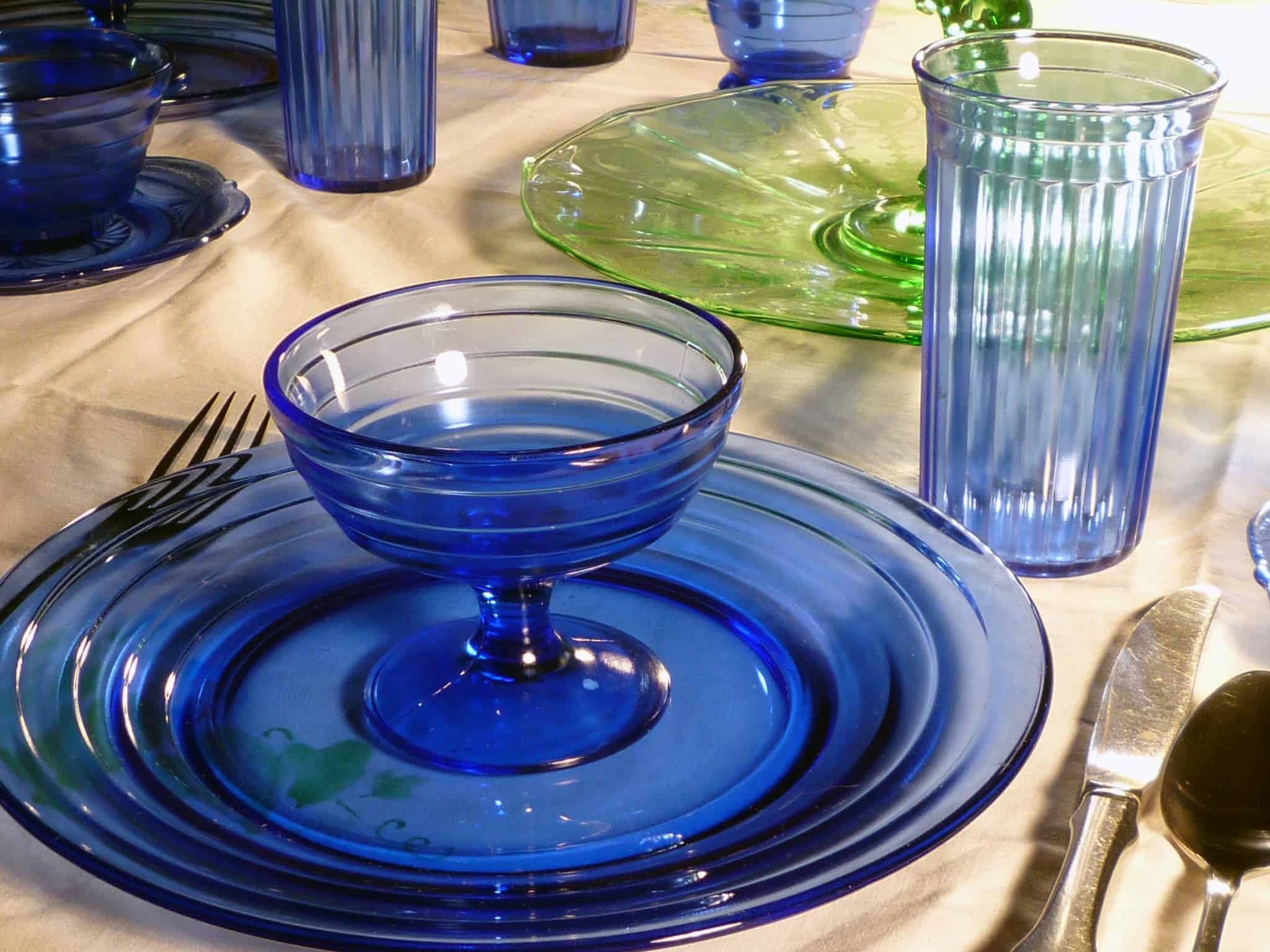
Hazel Atlas is the manufacturer of the aurora pattern depression glass. The company produced the glassware in the late 1930s, and the range of items is primarily available in cobalt blue. You can find delicate tableware like bowls, tumblers, and creamers.
5. Cameo Depression Glass Pattern
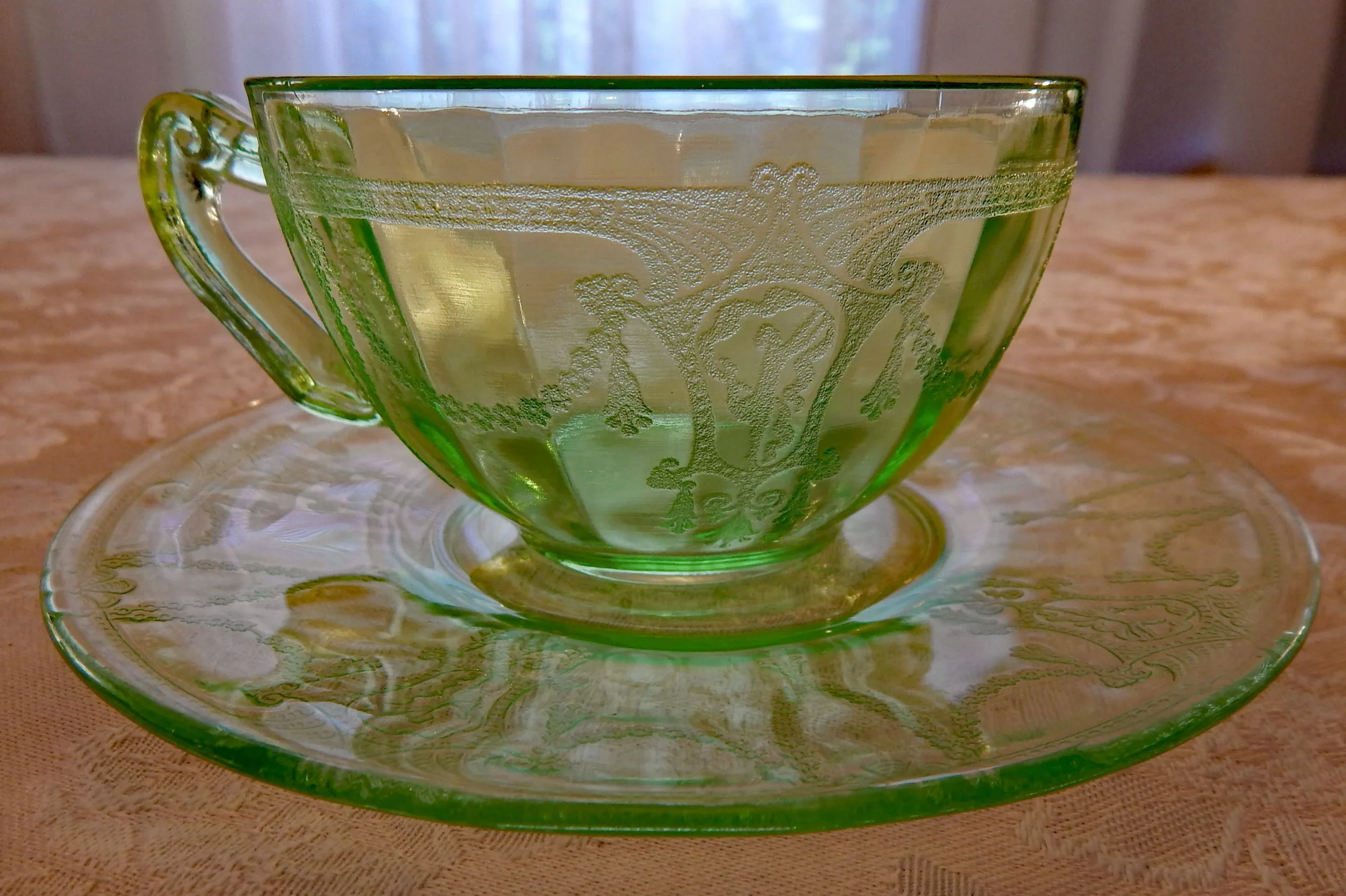
Anchor Hockings manufactured this depression glass pattern in 1930 and created many distinct pieces such as cookie jars, luncheons, and dinner plates.
6. Royal Lace

The royal lace pattern is by the Hazel-Atlas Glass company. The royal lace pattern started in 1934 and lasted till 1941. The initial colors of the pattern were green, pink, and crystal. But today, the most valuable royal lace pattern sets are available in cobalt blue, which has an interesting story behind its production.
Hazel-Atlas glass company manufactured Shirley-temple tableware sets through a contract with General Mills.
Due to some reasons, General Mills stopped production, and Hazel-Atlas was left with only one option: to use the blue glass for a royal lace pattern that improved to be a superhit, even better than the earlier colors.
7. Doric and Pansy Pattern

The product of Jeanette Glass, Doric, and Pansy is one of the least known depression glass patterns. You may have heard a lot about the floral and cherry blossom, but some other distinctive patterns did not get the deserved popularity.
The Doric and Pansy pattern is one of such underrated patterns that the company manufactured from 1937 to 1938 in dinnerware.
8. Holiday Depression Glass Pattern

The holiday is another glass pattern that is not truly a depression glass pattern. The company manufactured this pattern post-depression in 1947.
However, due to the company’s association with depression glass manufacturing, this pattern too became popular as a depression glass pattern and became collectible.
9. Georgian Depression Glass Pattern
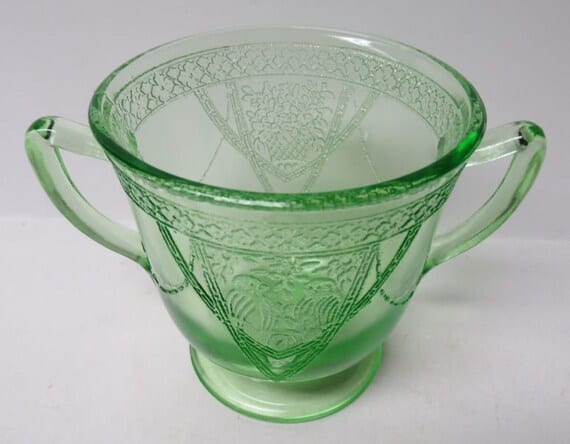
The Georgian depression glass pattern is a mid-ranged valuable pattern for today’s collectors. You can find pieces with this pattern by Federal glass company ranging from $10 to $125, depending on the availability of the work you’re searching for.
Glasses are the most expensive because people mostly break glasses from their sets. The Federal company produced this pattern from 1931 to 1936.
10. Mayfair Pattern

The Hocking Glass Company made this particular blue color that they dedicated to their Mayfair pattern in 1930. This blue color is specific to Hocking glassware only, and it stands between the sapphire blue and turquoise blue by other companies.
Hocking produced yellow and green colored Mayfair patterns, but now you will most commonly find this blue hue in the higher price range of collectible Mayfair patterns.
11. Moderntone Depression Glass Pattern
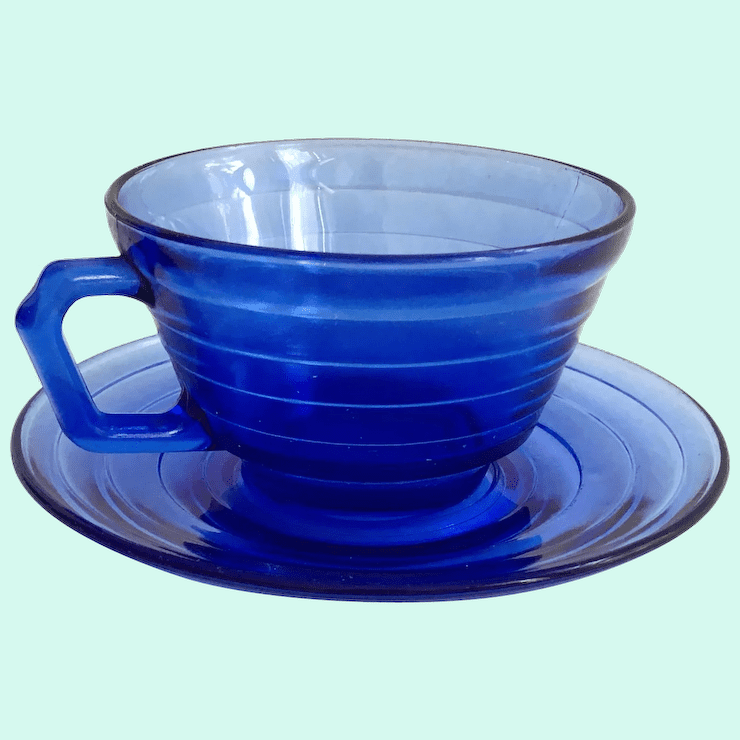
The modern tone, depression glass pattern, is a product of the Hazel-Atlas company. It was produced due to the excess blue glass left due to General Mills stopping the production of Shirley Temple tableware sets. This gave birth to three different patterns: Royal lace, modern tone, and Newport depression glass patterns).
Hazel Atlas produced this pattern from 1936 to 1942.
12. Iris & Herringbone Depression Glass Pattern
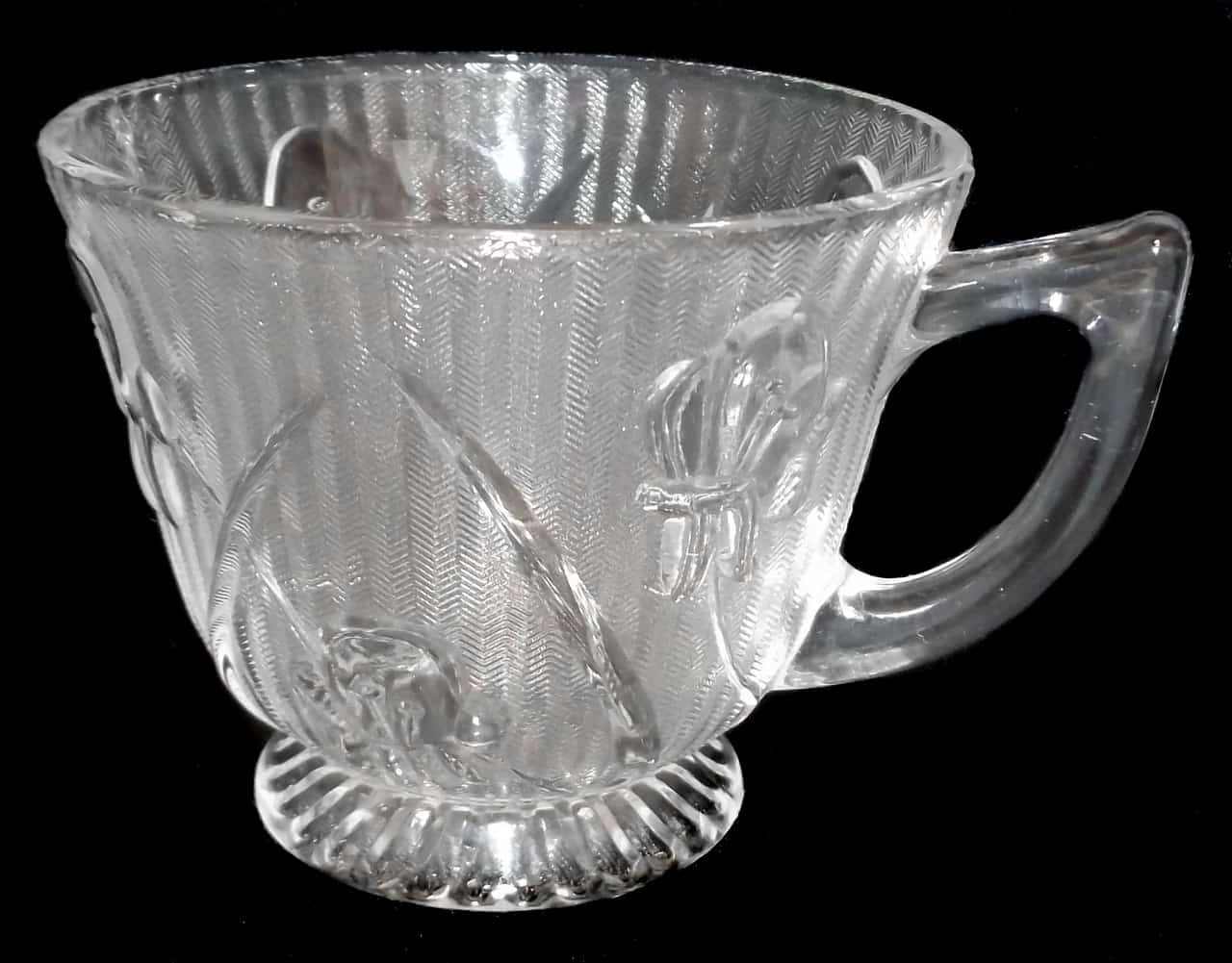
Manufactured by the Jeanette glass company between 1928 and 1932, Iris and herringbone are one of the most beautiful depression glass patterns.
You can find water and wine goblets, ruffled bowls, and giftware items. You can also find the pieces in the crystal; though the company produced green and pink hues, they are hard to find now.
13. The Patrician Pattern
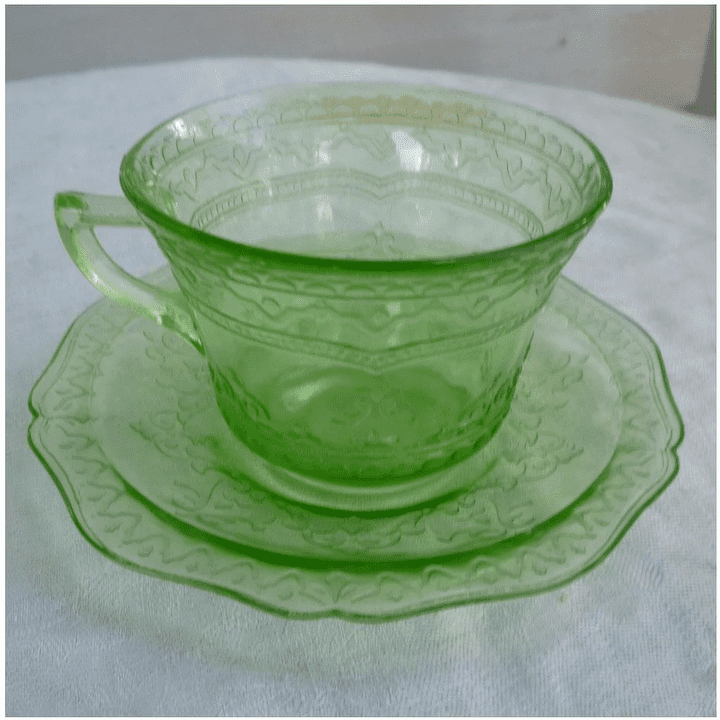
The Federal glass company manufactured the Patrician pattern, also known as the spoke pattern. The pattern was manufactured from 1933 to 1937, but the producer almost saturated the market with the pattern.
The pattern became a typical household pattern during its production years. One of the reasons was its promotion as a freebie in flour sacks. The most common color of the pattern is amber; you can find a set even now.
14. Waterford Pattern
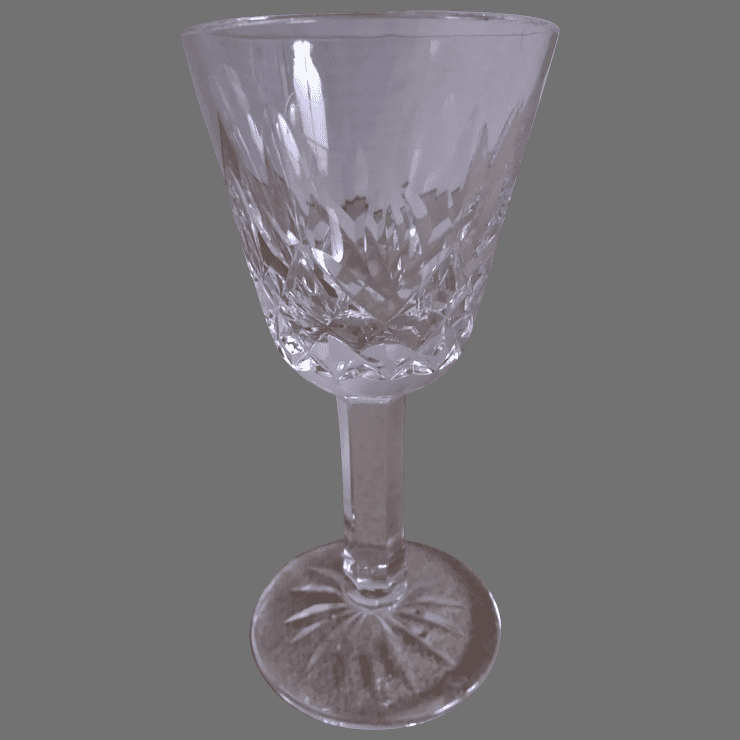
Anchor Hocking manufactured this depression glass pattern from 1938 to 1944. The product range was quite broad, with almost every tableware item available, from salt and pepper shakers to serving bowls.
15. Princess Depression Glass Pattern
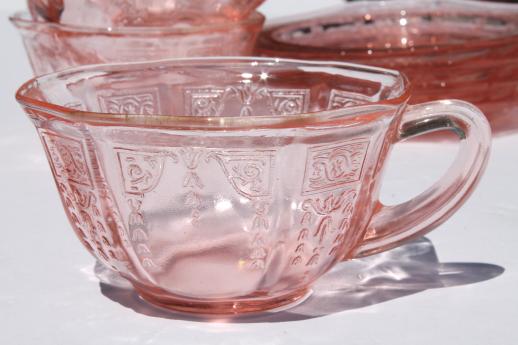
Princess was produced by Hocking from 1931 to 1934, during the early years of the Great Depression, and is one of their first mold-etched designs. The most valuable collectible color in the pattern is pink.
Almost all the other colors like topaz and green were beautiful in this pattern by Hocking.
Which Depression Glass Pattern Is Most Valuable?
Royal lace is the most sought-after depression glass pattern. Produced by the Hazel-Atlas glass company, the depression glass pattern comes in green, pink, crystal, and the most in-demand, cobalt blue, which was a random color.
The story behind cobalt blue is that Hazel-Atlas couldn’t manufacture its Shirley-Temple tableware sets because their production partner General Mills ended the contract.
So, Hazel Atlas was left with tanks of Ritz Blue glass which they had to use somehow. Therefore, the company opted to continue the royal lace pattern in the cobalt blue glass, an instant hit in the market and maintained its popularity.
Conclusion
There are almost a hundred depression glass patterns that manufacturers produced during the great depression. Not all of them are highly valuable today. The most famous depression glass pattern is the royal lace pattern created by the Hazel-Atlas glass company.
If you are looking for a collectible depression glass piece, you must take serious precautions in judging the piece’s originality since there are a ton of counterfeit products on the market.
Which depression glass are you leaning towards? Let us know in the comment below.
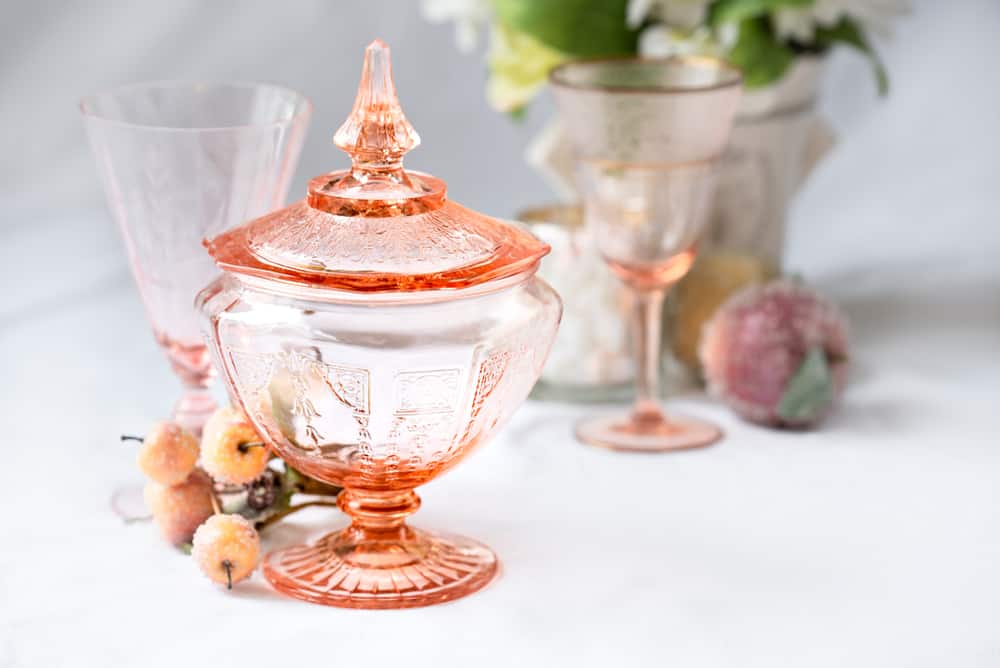
Did Federal Glass company make at 2 tiered sandwich server in amber Madrid??